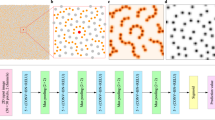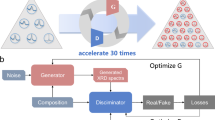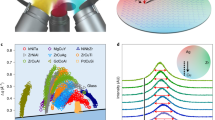Abstract
CONCEPTUAL notions of the structure of metallic alloy glasses have generally developed from purely geometrical sphere-packing models proposed for liquid1 and glassy2,3 monoatomic metals. The assumption on which these models are based is that the glass consists of a random arrangement of spherical atoms of each element—the so-called dense-random-packed (DRP) model. Glassy ‘metallic’ alloys of two or more chemically dissimilar elements can also be represented in this way, local atomic arrangements arising by chance, constrained only by geometrical factors such as the ratios of atomic radii. Construction of the model described here is based on an alternative principle commonly observed in amorphous solids of other types, namely that local structure is well-defined and almost always identical to that found in crystalline forms of the material. The properties of such a ‘stereochemically designed’ model have been computed and are found to be in reasonable agreement with high resolution neutron scattering data for glassy palladium–silicon alloys.
This is a preview of subscription content, access via your institution
Access options
Subscribe to this journal
Receive 51 print issues and online access
$199.00 per year
only $3.90 per issue
Buy this article
- Purchase on SpringerLink
- Instant access to full article PDF
Prices may be subject to local taxes which are calculated during checkout
Similar content being viewed by others
References
Bernal, J. D. Nature 183, 141–147 (1959); 185, 68–70 (1960); Proc. R. Soc. A280, 299–322 (1964).
Finney, J. L. Proc. R. Soc. A319, 479–93 (1970); Nature 266, 309–314 (1977).
Cargill, G. S. Solid State Physics (eds Ehrenreich, H., Seitz, F. & Turnbull, D.) 30, 227–320 (1975).
Mozzi, R. L. & Warren, B. E. J. appl. Crystallogr. 2, 164–172 (1969).
Urnes, S., Andreson, A. F. & Herstad, O. J. Non-cryst. Solids 29, 1–14 (1978).
Rundqvist, S. Arkiv Kemi 20, 67–113 (1962).
Tammann, G. Der Glaszustand, (Leopold Voss, Leipzig, 1933).
Polk, D. E. Acta metall. 20, 485–491 (1972).
Nagel, S. R. & Tauc, J. Phys. Rev. Lett. 35, 380–383 (1975).
Cahn, R. W. Nature 274, 848 (1978).
Gschneider, K. A. G. Solid State Physics (eds Ehrenreich, H., Sitz, F. & Turnbull, D.) 16, 275–426 (1964).
Suzuki, K., Fukunaga, T., Misawa, M. & Masumoto, T. Science Rep. Res. Inst. Tohoku Univ. 26 A, 1–11 (1976); proc. 3rd int. Conf. on Rapidly Quenched Metals (in the press).
Egami, T. J. Mater. Sci. (in the press).
Waseda, Y. Proc. 3rd int. Conf. on Rapidly Quenched Metals (in the press).
Author information
Authors and Affiliations
Rights and permissions
About this article
Cite this article
GASKELL, P. A new structural model for transition metal–metalloid glasses. Nature 276, 484–485 (1978). https://doi.org/10.1038/276484a0
Received:
Accepted:
Issue date:
DOI: https://doi.org/10.1038/276484a0
This article is cited by
-
Atomic motifs govern the decoration of grain boundaries by interstitial solutes
Nature Communications (2023)
-
Effect of composition and thermal history on deformation behavior and cluster connections in model bulk metallic glasses
Scientific Reports (2022)
-
A medium-range structure motif linking amorphous and crystalline states
Nature Materials (2021)
-
Atomic structure of a glass imaged at last
Nature (2021)
-
Low-Frequency Dynamics and Its Correlation of Nanoscale Structures in Amorphous Solids
Journal of Low Temperature Physics (2020)



